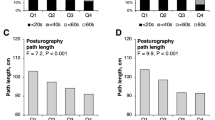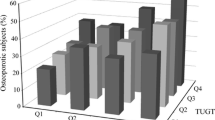Abstract
Summary
The main objective of this study was to explore whether vertebral fracture characteristics or posture is independently associated with physical performance. Posture was significantly associated with physical performance but fracture characteristics were not, suggesting posture should be the focus of physical performance variance.
Purpose
The main objective of this study was to explore whether vertebral fracture characteristics (number, severity, location) or occiput-to-wall distance (OWD) is independently associated with physical performance.
Methods
This was a secondary data analysis using baseline data from a randomized controlled trial, of community-dwelling women aged 65 years and older with a suspected vertebral fragility fracture. Lateral thoracic and lumbar spine radiographs were used to determine the number, location, and severity of fracture. The dependent variables were timed up and go (TUG), five times sit-to-stand, four-meter walk, and step test. The independent variables were number, severity, location of fracture, and OWD. Pain during movement and age were covariates. Multivariable regression analyses determined the association between each of the dependent and independent variables.
Results
Participants’ (n = 158) mean (standard deviation [SD]) age was 75.9 (6.5) years. They had a mean (SD) BMI, OWD, and number of fractures of 26.7 (5.3) kg/m2, 5.7 (4.6) cm, and 2.2 (1.8), respectively. OWD was independently associated with TUG (estimated coefficient [B] = 0.29, 95% confidence interval [CI] = 0.16, 0.42), five times sit-to-stand (B = 0.33, 95% CI = 0.12, 0.55), four-meter walk (B = 0.09, 95% CI = 0.05, 0.13), and step test (B = − 0.36, 95% CI = − 0.50, − 0.23) in the unadjusted model. OWD was independently associated with TUG (B = 0.25, 95% CI = 0.12, 0.38), five times sit-to-stand (B = 0.29, 95% CI = 0.07, 0.50), four-meter walk (B = 0.08, 95% CI = 0.03, 0.12), and step test (B = − 0.22, 95% CI = − 0.47, − 0.19) in the adjusted model.
Conclusion
OWD was significantly associated with physical performance but fracture characteristics were not. These analyses were exploratory and require replication in future studies.



Similar content being viewed by others
References
Balzini L, Vannucchi L, Benvenuti F, Benucci M, Monni M, Cappozzo A, Stanhope SJ (2003) Clinical characteristics of flexed posture in elderly women. J Am Geriatr Soc 51(10):1419–1426
Ensrud KE (2013) Epidemiology of fracture risk with advancing age. J Gerontol A Biol Sci Med Sci 68(10):1236–1242
Melton Iii L, Atkinson E, Cooper C, O’Fallon W, Riggs B (1999) Vertebral fractures predict subsequent fractures. Osteoporosis Int 10(3):214–221
van der Jagt-Willems HC, van Hengel M, Vis M, van Munster BC, van Campen JP, Tulner LR et al (2012) Why do geriatric outpatients have so many moderate and severe vertebral fractures? Exploring prevalence and risk factors. Age Ageing 41(2):200–206
Lindsay R, Silverman SL, Cooper C, Hanley DA, Barton I, Broy SB et al (2001) Risk of new vertebral fracture in the year following a fracture. J Am Med Assoc 285(3):320–323
Lynn SG, Sinaki M, Westerlind KC (1997) Balance characteristics of persons with osteoporosis. Arch Phys Med Rehabil 78(3):273–277
De Groot MH, van der Jagt-Willems HC, van Campen JPCM, Lems WF, Beijnen JH, Lamoth CJC (2014) A flexed posture in elderly patients is associated with impairments in postural control during walking. Gait Posture 39(2):767–772
Siminoski K, Warshawski RS, Jen H, Lee K (2003) Accuracy of physical examination using the rib-pelvis distance for detection of lumbar vertebral fractures. Am J Med 115(3):233–236
Cortet B, Roches E, Logier R, Houvenagel E, Gaydier-Souquières G, Puisieux F, Delcambre B (2002) Evaluation of spinal curvatures after a recent osteoporotic vertebral fracture. Joint Bone Spine 69(2):201–208
Kado DM, Miller-Martinez D, Lui L, Cawthon P, Katzman WB, Hillier TA et al (2014) Hyperkyphosis, kyphosis progression, and risk of non-spine fractures in older community dwelling women: the Study of Osteoporotic Fractures (SOF). J Bone Miner Res 29(10):2210–2216
Cooper C, Atkinson EJ, O’Fallon WM, Melton LJ III (1992) Incidence of clinically diagnosed vertebral fractures: a population-based study in Rochester, Minnesota, 1985-1989. J Bone Miner Res 7(2):221–227
Liu-Ambrose T, Eng JJ, Khan KM, Carter ND, McKay HA (2003) Older women with osteoporosis have increased postural sway and weaker quadriceps strength than counterparts with normal bone mass: overlooked determinants of fracture risk? J Gerontol Ser A Biol Sci Med Sci 58(9):862–866
Siminoski K, Warshawski RS, Jen H, Lee K (2011) The accuracy of clinical kyphosis examination for detection of thoracic vertebral fractures: comparison of direct and indirect kyphosis measures. J Musculoskelet Neuronal Interact 11(3):249–256
Baert V, Gorus E, Mets T, Bautmans I (2015) Motivators and barriers for physical activity in older adults with osteoporosis. J Geriatr Phys Ther 38:105–114
Kado DM, Huang MH, Nguyen CB, Barrett-Connor E, Greendale GA (2007) Hyperkyphotic posture and risk of injurious falls in older persons: the Rancho Bernardo Study. J Gerontol A Biol Sci Med Sci 62(6):652–657
Giangregorio LM, Thabane L, Adachi JD, Ashe MC, Bleakney RR, Braun EA, Cheung AM, Fraser LA, Gibbs JC, Hill KD, Hodsman AB, Kendler DL, Mittmann N, Prasad S, Scherer SC, Wark JD, Papaioannou A (2014) Build better bones with exercise: protocol for a feasibility study of a multicenter randomized controlled trial of 12 months of home exercise in women with a vertebral fracture. Phys Ther 94(9):1337–1352
Wongsa S, Amatachaya P, Saengsuwan J, Amatachaya, S (2012) Concurrent validity of occiput-wall distance to measure Kyphosis in communities. J Clin Trials, 2(10.4172), 2167–0870
van der Jagt-Willems HC, de Groot MH, van Campen JP, Lamoth CJ, Lems WF (2015) Associations between vertebral fractures, increased thoracic kyphosis, a flexed posture and falls in older adults: a prospective cohort study. BMC geriatrics, 15(1), 34
Shipe NK, Billek-Sawhney B, Canter TA, Meals DJ, Nestler JM, Stumpff JL (2013) The intra-and inter-rater reliability of the tragus wall distance (TWD) measurement in non-pathological participants ages 18–34. Physiother Theory Pract 29(4):328–334
Genant HK, Jergas M, Palermo L, Nevitt M, San Valentin R, Black D et al (1996) Comparison of semiquantitative visual and quantitative morphometric assessment of prevalent and incident vertebral fractures in osteoporosis. J Bone Miner Res 11(7):984–996
Johansson H, Odén A, McCloskey E, Kanis J (2014) Mild morphometric vertebral fractures predict vertebral fractures but not non-vertebral fractures. Osteoporosis Int 25(1):235–241
Podsiadlo D, Richardson S (1991) The timed ‘Up and Go’: a test of basic functional mobility for frail elderly persons. J Am Geriatr Soc 39(2):142–148
Kennedy DM, Stratford PW, Wessel J, Gollish JD, Penney D (2005) Assessing stability and change of four performance measures: a longitudinal study evaluating outcome following total hip and knee arthroplasty. BMC Musculoskelet Disord 6(1):3
Wright AA, Cook CE, Baxter GD, Dockerty JD, Abbott JH (2011) A comparison of 3 methodological approaches to defining major clinically important improvement of 4 performance measures in patients with hip osteoarthritis. J Orthop Sports Phys Ther 41(5):319–327
Meretta BM, Whitney SL, Marchetti GF, Sparto PJ, Muirhead RJ (2006) The five times sit to stand test: responsiveness to change and concurrent validity in adults undergoing vestibular rehabilitation. J Vestibular Res Equilib Orientat 16(4–5):233–243
Tiedemann A, Shimada H, Sherrington C, Murray S, Lord S (2008) The comparative ability of eight functional mobility tests for predicting falls in community-dwelling older people. Age Ageing 37(4):430–435
Lord SR, Murray SM, Chapman K, Munro B, Tiedemann A (2002) Sit-to-stand performance depends on sensation, speed, balance, and psychological status in addition to strength in older people. J Gerontol Ser A Biol Med Sci 57(8):M539–M543
Guralnik JM, Simonsick EM, Ferrucci L, Glynn RJ, Berkman LF, Blazer DG, Scherr PA, Wallace RB (1994) A short physical performance battery assessing lower extremity function: association with self-reported disability and prediction of mortality and nursing home admission. J Gerontol 49(2):M85–M94
Kim HJ, Park I, Lee HJ, Lee O (2016) The reliability and validity of gait speed with different walking pace and distances against general health, physical function, and chronic disease in aged adults. J Exerc Nutr Biochem 20(3):46–50
Hill KD, Bernhardt J, McGann AM, Maltese D, Berkovits D (1996) A new test of dynamic standing balance for stroke patients: reliability, validity and comparison with healthy elderly. Physiother Can 48(4):257–262
Hong S, Goh EY, Chua SY, Ng SS (2012) Reliability and validity of step test scores in subjects with chronic stroke. Arch Phys Med Rehabil 93(6):1065–1071
Antonelli-Incalzi R, Pedone C, Cesari M, Di Iorio A, Bandinelli S, Ferrucci L (2007) Relationship between the occiput-wall distance and physical performance in the elderly: a cross sectional study. Aging Clin Exp Res 19(3):207–212
Sun G, Shook TL, Kay GL (1996) Inappropriate use of bivariable analysis to screen risk factors for use in multivariable analysis. J Clin Epidemiol 49(8):907–916
Liu-Ambrose T, Eng JJ, Khan KM, Mallinson A, Carter ND, McKay HA (2002) The influence of back pain on balance and functional mobility in 65- to 75-year-old women with osteoporosis. Osteoporosis Int 13(11):868–873
Briggs AM, Wrigley TV, Van Dieën JH, Phillips B, Lo SK, Greig AM et al (2006) The effect of osteoporotic vertebral fracture on predicted spinal loads in vivo. Eur Spine J 15(12):1785–1795
Yamashita T, Minaki Y, Oota I, Yokogushi K, Ishii S (1993) Mechanosensitive afferent units in the lumbar intervertebral disc and adjacent muscle. Spine 18(15):2252–2256
Sinaki M, Brey RH, Hughes CA, Larson DR, Kaufman KR (2005) Balance disorder and increased risk of falls in osteoporosis and kyphosis: significance of kyphotic posture and muscle strength. Osteoporosis Int 16(8):1004–1010
Katzman WB, Vittinghoff E, Kado DM (2011) Age-related hyperkyphosis, independent of spinal osteoporosis, is associated with impaired mobility in older community-dwelling women. Osteoporosis Int. 22(1):85–90
Arnold CM, Faulkner RA (2007) The history of falls and the association of the timed up and go test to falls and near-falls in older adults with hip osteoarthritis. BMC Geriatr 7(1):1
Jonsson E (2006) Effects of healthy aging on balance: A quantitative analysis of clinical tests. Institutionen för klinisk neurovetenskap, arbetsterapi och äldrevårdsforskning (NEUROTEC)/Department of Clinical Neuroscience, Occupational Therapy and Elderly Care Research (NEUROTEC)
Herman T, Giladi N, Gurevich T, Hausdorff JM (2005) Gait instability and fractal dynamics of older adults with a "cautious" gait: why do certain older adults walk fearfully? Gait Posture 21(2):178–185
Blennerhassett JM, Dite W, Ramage ER, Richmond ME (2012) Changes in balance and walking from stroke rehabilitation to the community: a follow-up observational study. Arch Phys Med Rehabil 93(10):1782–1787
Pluijm S, Tromp A, Smit J, Deeg D, Lips P (2000) Consequences of vertebral deformities in older men and women. J Bone Miner Res 15(8):1564–1572
Bansal S, Katzman WB, Giangregorio LM (2014) Exercise for improving age-related hyperkyphotic posture: a systematic review. Arch Phys Med Rehabil 95(1):129–140
Funding
The research was funded by a CIHR Operating grant (MOP: 123445). Dr. Giangregorio received funding from an Ontario Ministry of Health Research and Innovation- Early Researcher Award, CIHR New Investigator Award, the Canadian Foundation for Innovation, and the Bloomberg Manulife Prize. Dr. Ashe acknowledges the support of the Canada Research Chairs program. Dr. Cheung is supported by a Tier 1 CRC in Musculoskeletal and Postmenopausal Health as well as the Lillian Love Chair in Women’s Health at the University of Toronto and University Health Network. Dr. Gibbs received funding from a CIHR Fellowship Award.
Author information
Authors and Affiliations
Contributions
Christina M.D. Ziebart, Jonathan D. Adachi, Maureen C. Ashe, Robert R. Bleakney, Angela M. Cheung, Jenna C. Gibbs, Keith D. Hill, David L. Kendler, Aliya A. Khan, Sandra Kim, Caitlin McArthur, Nicole Mittmann, Alexandra Papaioannou, Sadhana Prasad, Samuel C. Scherer, Lehana Thabane, John D. Wark, and Lora M. Giangregorio have all provided meaningful contributions to this manuscript.
Corresponding author
Ethics declarations
Conflict of interest
None.
Additional information
Publisher’s note
Springer Nature remains neutral with regard to jurisdictional claims in published maps and institutional affiliations.
Rights and permissions
About this article
Cite this article
Ziebart, C., Gibbs, J.C., McArthur, C. et al. Are osteoporotic vertebral fractures or forward head posture associated with performance-based measures of balance and mobility?. Arch Osteoporos 14, 67 (2019). https://doi.org/10.1007/s11657-019-0626-x
Received:
Accepted:
Published:
DOI: https://doi.org/10.1007/s11657-019-0626-x




